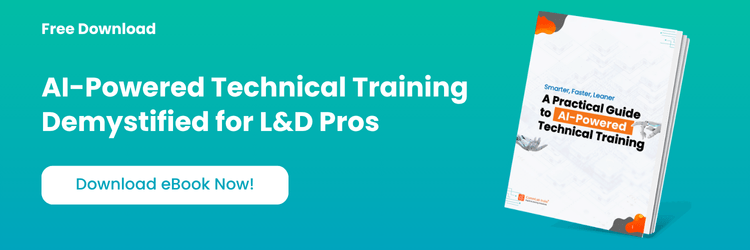Curriculum planning can feel like a mountain, especially when you’re designing technical training for fast-paced sales and service teams.
There are competing priorities:
- Multiple roles to support
- Products that change every quarter
- Compliance requirements
- Field feedback coming in daily
Add global rollouts and multiple languages, and it’s easy to get stuck in analysis paralysis.
But AI changes the equation. With the right tools and a lean mindset, you can move from overwhelm to action and design a technical curriculum that is structured, agile, and scalable.
Table Of Content
- The Curriculum Bottleneck
- Shift to Modular, AI-Accelerated Design
- Case Study: Regional Service Curriculum
- AI Tools That Help
The Curriculum Bottleneck
Traditional planning starts with:
- Role analysis
- Content mapping
- Bloated course blueprints
- Long development timelines
It often results in huge learning journeys that learners never finish, and content that’s outdated before it launches.

Shift to Modular, AI-Accelerated Design
How Can You Create an AI-Driven Modular Design for Technical Training?
Follow these simple steps to streamline your design process and maximize efficiency:
- Define your learning zones
- Segment by role and experience
- Use AI to draft the curriculum structure
- Design for sprints
- Plan reinforcement in parallel
AI helps speed up curriculum planning by:
- Organizing inputs from SMEs and stakeholders
- Mapping tasks to competencies
- Drafting learning paths for multiple personas
Let’s break down a smarter planning model.
Step 1: Define Your Learning Zones
Start by identifying the core categories that support performance:
- Product knowledge
- Process mastery (e.g., troubleshooting, quoting)
- Tools & systems
- Compliance
- Soft skills (e.g., handling objections, service recovery)
Each zone becomes a learning track.
Step 2: Segment by Role and Experience
Use AI tools to segment content based on:
- Job role (inside sales, field tech, etc.)
- Experience level (new hire vs. expert)
ChatGPT or Claude can help build:
- Role-specific task matrices
- Skill checklists
- Priority heatmaps
This ensures your content is focused and avoids teaching basic features to senior engineers.

AI-Powered Technical Training – A Practical Guide
- Training formats that work best for technical learners
- 3-touchpoint model for seamless collaboration with SMEs
- Practical tools and templates
- And More!
Step 3: Use AI to Draft the Curriculum Structure
Give your SME transcripts, role maps, and product briefs to ChatGPT and prompt:
“Generate a 3-month modular training plan for service engineers supporting [product]. Include weekly learning goals, formats, and assessments.”
Gartner outlines a 2025 tech adoption roadmap where businesses are increasingly leveraging AI to enhance content processes.
Learn how AI is transforming corporate training by creating impactful, tailored content that boosts engagement and learning outcomes!
You’ll get:
- A content calendar
- Suggestions for microlearning vs. simulation
- Embedded assessment ideas
Use it as a draft, then tailor for your context.
Step 4: Design for Sprints
Avoid the waterfall trap. Use 2-week sprints:
- Sprint 1: New product QRG + install video
- Sprint 2: Troubleshooting roleplay + reinforcement quiz
- Sprint 3: Objection handling simulator + checklist
Each sprint delivers standalone value—and can be reused in onboarding later.
Step 5: Plan Reinforcement in Parallel
Don’t treat reinforcement as Phase 2. Use AI to:
- Auto-generate spaced quiz sets
- Recommend follow-up content
- Create chatbot Q&A sets based on SOPs
Deploy via MaxLearn, Qstream, or your Learning Management System (LMS).
Case Study: Regional Service Curriculum
A healthcare tech company planned a training path for field service engineers across Southeast Asia. Instead of a 12-month monolith, they used AI to:
- Segment roles by product line
- Build modular paths using SME call transcripts
- Translate and localize content in 5 languages
The rollout started in 4 weeks and included:
- 5 learning zones
- 22 micro-courses
- 3 simulations
- Weekly nudges
Uptake was 3X higher than previous training programs.
AI Tools That Help
- ChatGPT: Curriculum scaffolding
- Notion AI: Task tracking and rollout maps
- Smartcat: Translations and content reusability
- Synthesia: Fast, multilingual content production
- Qstream: Embedded reinforcement
Final Thought
Curriculum planning doesn’t have to be a bottleneck.
AI enables a lean, responsive, and field-friendly approach. You can move faster, focus on what matters, and keep sales and service teams trained on the things they’ll use tomorrow—not what they should have learned last year.
Build it in sprints. Plan for reuse. Reinforce by design.
That’s curriculum planning at the speed of business.







